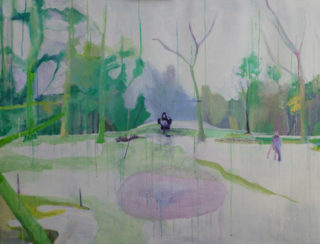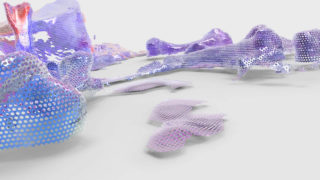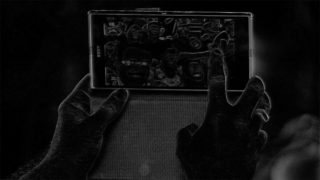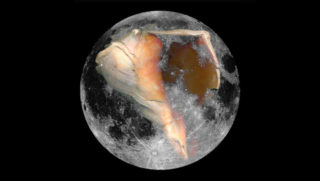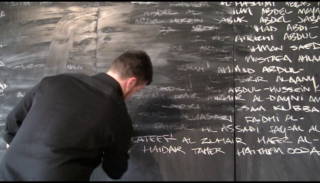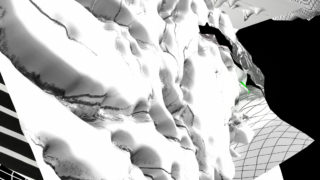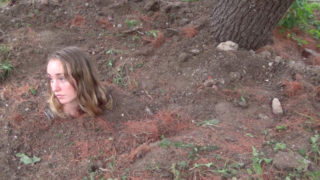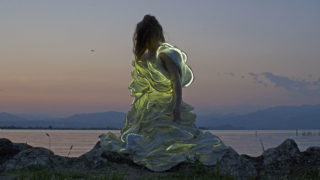Written by Elizabeth Young ’20 and Isabelle Sakelaris ’19
Passing through the atrium of the E. Craig Wall Jr. Academic Center, visitors can’t help but notice the giant video wall often used for presentations and lectures. When the wall is not being used for presentations, you can see a number of digital artworks, initially selected by members of the Art Collection Advisory Committee, as well as by a few Davidson College Faculty and Staff. This year, the Van Every & Smith Galleries hosted a contest to decide which of thirty new works by contemporary digital artists to acquire for the space.
On October 2, Gallery interns talked about each of the works available for purchase, and shared stories about their favorites. The Galleries relied on the public’s votes to determine which pieces to acquire. The goal of the event was to foster a sense of community involvement in the art acquisition process while celebrating the unique contributions of each artist and video. In the end, the Galleries initiated a Give Campus Campaign, successfully raising $7,530 with the support of 69 donors to help acquire ten new digital artworks for the college’s collection! The following works were selected for the permanent art collection through public vote:
Manhole by Alexandra Neuman
Alexandra Neuman studied studio art and anthropology at the Washington University in St. Louis and is currently an M.F.A. candidate at the University of California, San Diego. In Manhole, viewers encounter the artist’s experience of literally “reuniting with the earth”–the artist is shown buried to the neck in the ground. Neuman remarks that one of her most recent inspirations in her work has been the practice of Buddhist mindfulness meditation, as a way of grounding herself in the moment at a particular time when technology takes so much precedence in our lives. Neuman’s work in a digital medium is an attempt to create new technologies that can “make us whole.”Manhole is indeed meditative, as it forces the viewer to slow down and observe the artist’s presence in nature–a presence that is mediated digitally.
The World is Breathing by Olivia Crumm
Olivia Crumm is based in Mexico City, where she works in digital art and photography. She received her B.A. in Studio Art from Bard College in 2017. The World is Breathing was Crumm’s thesis at Bard. The work creates a space where the viewer can reflect on and observe patience and stillness. Crumm’s analysis of The World is Breathing states, “stillness is quiet but it moves; it breathes in a moment of drawn out motion–a slow inhale.” Like Manhole, The World is Breathing relies on a digital medium for its message; rather than seeing an artwork all at once, like in a photograph, the viewer must wait for the video to reveal itself over time, in essence, allowing the viewer to watch the world breathe in real time as they watch the video.
Collide Cut III by Charles Sommer
Charles Sommer is an artist based in Brooklyn, NY who earned his B.F.A. from University of South Florida and his M.F.A. from CUNY Brooklyn College. He is interested in the intersection of the physical and digital worlds through the lens of dimensionality and time. Collide Cut III is an investigation of a world of Sommer’s own making, which is indebted to his understanding of the theories of quantum physics and the infinite potential for investigation. The piece uses shapes and planes moving and intersecting at different speeds to question the makeup of space and time as we know it.
Discovery of Venus by Elizabeth Tolson
Elizabeth Tolson is an artist and educator living and working in New York. She earned her B.F.A. at Alfred University and her M.F.A from Parson’s Design School. Tolson is principally interested in multimedia works that present a feminist viewpoint. This work takes a philosophical spin on Botticelli’s famous work, The Birth of Venus, by challenging the ancient constitutions of beauty. The Discovery of Venus acknowledges both the history of the female body as well as modern society’s push to revolutionize how women view themselves. Tolson designed the dress in the video with LED lights inside in order to show how garments, light, and the body interact. From a feminist stance, this interaction is rife with interesting consequences.
Zombie Boyfriend by Case Jernigan
Many of Case Jernigan’s works use paper cut-outs, stop motion, and doodle drawings to remind viewers of their childhood. Using these styles, his piece explores the connection between the imaginary and real heroes and the monsters of childhood vs. adulthood. The piece brings a sense of levity and humor to its dark themes, making the important questions the artist considers accessible and interesting. Case Jernigan’s artwork has been commissioned by The New York Times, NIKE, The Guardian, Adidas, Chelsea FC, and The Oxford University Press, among other impressive institutions.
Digital Artefacts (Chernobyl) by Timothy Neill
Timothy Neill earned his B.F.A. from California College of Fine arts and his M.F.A. from Notre Dame University. In an explanation of his work, Neill writes, “an ‘artefact’ is an anomaly observed or any unintended matter in the failure of a digital process, especially one introduced by a new or experimental technology. Digital Artefacts is one such artefact that focuses on Neill’s most notable research: a selection of objects he researched at the Chernobyl Exclusion Zone, which he recreated through 3D scanning. Neill explores the complicated relationship between humans and technology as well as the idea that technological advancements resemble human evolutionary biology in this work.
Ancestors by Cynthia Farnell
Cynthia Farnell lives and works in Atlanta, GA, where she is the director of the Welch School Galleries at Georgia State University. She earned her B.F.A. from Auburn University and her M.F.A. from the Rhode Island School of Design. Farnell’s works interrogate concepts of history, memory, and community. This work is one such example; Ancestors takes on a dream-like quality as the artist presents 150 years of her family history in a mere eight-minute video. Ancestors reflects on the dispersion of her family members and provides few details on their past, leaving the viewer to speculate about these almost ghostly distant lives.
Simulacrum by Jason Bernagozzi
Jason Bernagozzi earned his B.F.A from the Kansas City Art Institute and his M.F.A. from Alfred University. He is also the founder of the artists’ nonprofit Signal Culture. His work is indebted to explorations of digital media and technology as an evolving world language. In Simulacrum Preveiw, Bernagozzi investigates time-based media in by combining video, sound, and other electronic forms. Simulacrum Preview presents an eerie depiction of daily life and regular people, prompting the viewer to reflect on what they consider “regular.”
Moon on a String by Viviane Silvera
Viviane Silvera earned her B.A. from Tufts University and her M.F.A. from the New York Academy of Art. In her work, Silvera applies layers of wet paint to a given surface to create a story through stop motion video. Through this method, Silvera puts memory into motion, exploring the ways that mystery and magic relate to memories. Silvera’s work has been featured by The New York Times, and The Wall Street Journal, amongst other noteworthy media outlets. Her documentary See Memory , which was screened at the American Psychological Association Film Festival and the Imagine Science Film Festival, is currently available on Amazon
Wipe the Slate by Chris Revelle
Chris Revelle earned his B.F.A. from Savannah College of Art and Designs and his M.F.A. from California Institute of the Arts. He currently lives and works in Atlanta, Georgia. In Wipe the Slate, Revelle claims solidarity with Iraqi academics by writing and rewriting the Brussels Tribunal’s appeal to help Iraq’s intellectuals. The Brussels Tribunal is a community of activists, intellectuals, and artists who organized a series of hearings to draw awareness to the systematic targeting of Iraq’s academics and intellectuals. The process of writing and erasure in this piece symbolize Revelle’s attempt to claim solidarity with Iraqi intellectuals and to draw attention to their erasure from society and history.
Thanks to all of our interns for their work on the Cast Your Vote event on October 2. Also, special thanks to all of our donors and advocates who helped support this endeavor!
Malu Alvarez ’02
Charlotte Artus
Dan McLawhorn ’70
Susan Baik & Prem Manjooran ’91
Jeff Prince & Michael Jolly
Lia Newman & Chris Gannon
Jamie Knowles ’10
Frank Lord ’89
Elena Paul ’85
Amy Clemmons King ’97
Lisa Combs ’90
Lyn Bolen Warren ’83 & Russ Warren
Jane & Bob Avinger
Douglas Noreen
Nan & Bill Loftin ’81
Laurie Ballenger
Ralph Blakely ’63
Dan Drayer
Tatum Pottenger
Nina E. Serebrennikov
Kaky McGinness Grant ’01
Allison Tolbert
Camille Cooper
Stephanie Glaser ’92 and Thomas Hazel
Peter & Bess Kelpin ’12
Madeline & Lawrence Newman
Kate Hall ’15
Sherry Nelson
Victor Allen-Weeks ’19
Tyler Wilson ’16
Diana Waller
Anne Porges & Julio Ramirez
Anna K. Clay
Holly Sinkway
Carmel & Louis Toriello
Alana Juneau
Elizabeth Harry ’14
Caitlin James ’14
Jason Radcliffe
Megan Pottenger ’19
Jessica Olson
Rebecca Pempek ’20
Andy Simmons
Emilie Hoke ’21


